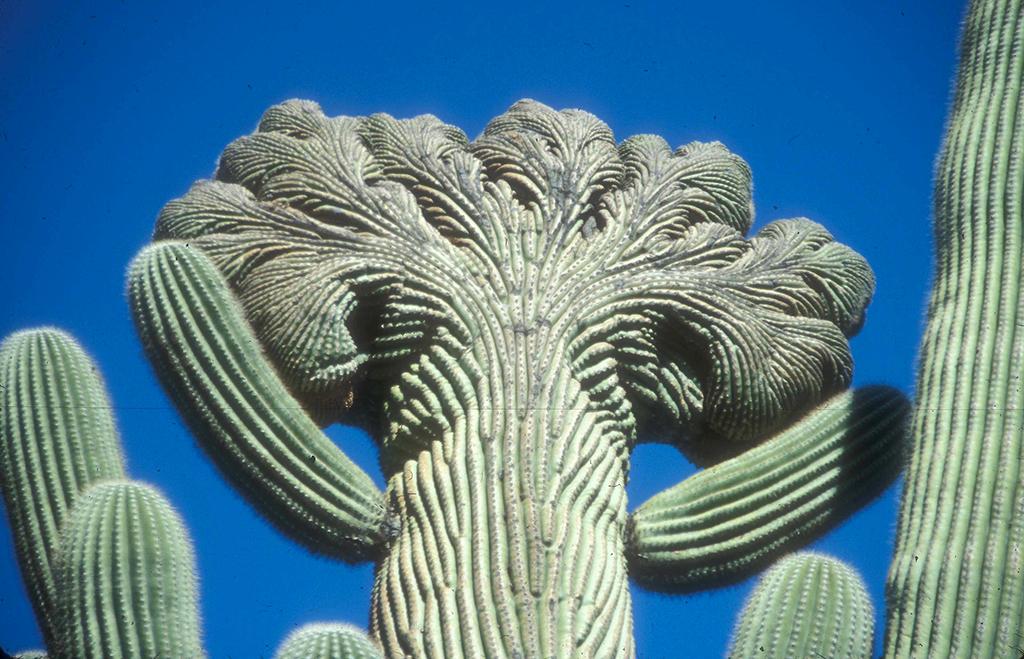Many landmarks and landscapes are named after some specific feature. Saguaro National Park in Arizona is one such place. Here, you can see “forests” of saguaro (suh-waa-row) cactus (aka giant cactus). They are easily recognizable because the upturned arms of a saguaro looks like it is in a perpetual state of surprise.

A centennial saguaro at Saguaro National Park / Jennifer Bain
Featured In The National Parks Traveler
Saguaro Arms And Other Cactus Musings In Tucson
There’s a four-armed saguaro living on the western edge of Tucson that has one broken arm, one newborn arm, one thick older arm pointing to the Arizona sky and one slender younger arm pointing towards the Sonoran Desert soil.
It’s not the prettiest, greenest or healthiest-looking cactus around. But of all the cacti I admired in Saguaro National Park, it’s the one that made the biggest impression.
I wondered what Don Swann would say about it. He’s the park biologist in charge of a Saguaro Arms Citizen Science Project that launched last March and runs to April. He realized that saguaros may be America’s largest cactus and the icons of the southwest, but little is known about their massive branches (aka arms) that can produce the flowers and seeds needed for reproduction. The more arms there are, the better the chances are that a seed will take root and become a beautiful new saguaro.
To read more of this article, head over to this page.
Counting Cacti At Saguaro National Park
Take saguaros out of Saguaro National Park, and you’d lose more than the park’s namesake cactus, one that gives skyward structure to the vista here.
You might be left straining to catch the drumming of the Gila woodpecker, fail to catch an elf owl peering out from its cavity nest, and not know where to look for Lesser long-nosed bats. All these creatures rely on the saguaro for food and/or shelter.
To read more of this article, head over to this page.
Saguaro National Park Using New Technology To Deter Cactus Rustlers
Saguaro National Park is using some new technology to help deter an old-time problem - cactus poachers. Operation PIT Tag inserts tiny micro-chips into cacti to allow positive identification of saguaro cacti which have been heisted from the park. The program makes those plants less attractive targets for rustlers, since it's easy to verify that a tagged cactus is "stolen goods."
Saguaros are very slow-growing; after 15 years the cactus may be only a foot tall, and a seven-footer may be about 50 years of age. The large, showy flowers don't appear until a plant is around 35 years old, and it can take as long as 75 years for the prized "arms" that give a saguaro its signature shape to form. A multi-armed giant is likely more than a century old, and weighs several tons.
To read more of this article, head over to this page.
Saguaro National Park at Risk
With 1.6 million saguaro cacti, the National Parks Conservation Association calls Saguaro National Park “the largest forest of its kind on the planet.”
“It almost doesn’t qualify as a desert because it gets enough precipitation that it grades into what’s called a subtropical thorn scrub forest,” notes Tice Supplee of Audubon Southwest.
Or, at least, that has been the case, historically.
Today, numerous species living there, including the signature cactus, face many challenges — urban development, invasive species, drought and wildfires amplified by climate change, rank among the most-pressing.
To read more of this article, head over to this page.
While wandering the landscape, you might notice that some saguaros, however, don’t look so much “surprised” as, perhaps, “baroque,” if you were to give this cactus an adjective. Sometimes you will see a saguaro with a fan-like structure to it at the very top. This is a cristate, or crested, saguaro.

A cristate, or crested saguaro, Saguaro National Park / NPS file
According to park staff:
Some saguaros develop a unique fan-shaped pattern at the growing tip. This consists of hundreds of small folds, or pleats, similar to much larger "ribs" found on the skin of the saguaro trunk. Only about 75 saguaros with this crested, or cristate, growth form have been found in the park.
Biologists disagree about why some saguaros grow in this unusual form. Some speculate that it is a genetic mutation. Others say it is the result of freeze damage or lightning strike. At this point, we simply do not know what causes this rare, crested form. Even if the saguaro has a cristate pattern, it will still produce viable flowers, fruits and possibly arms. Like all columnar saguaros, no two crested saguaros are the same. Many mysterious growth formations can happen in a cristate. For example, a regular arm can grow from the crest and arms themselves can also be crested.





